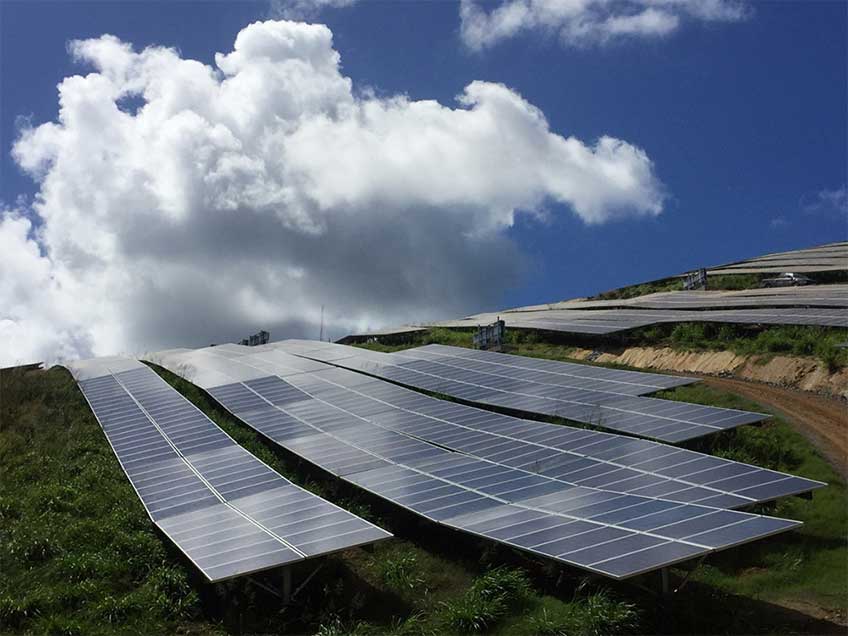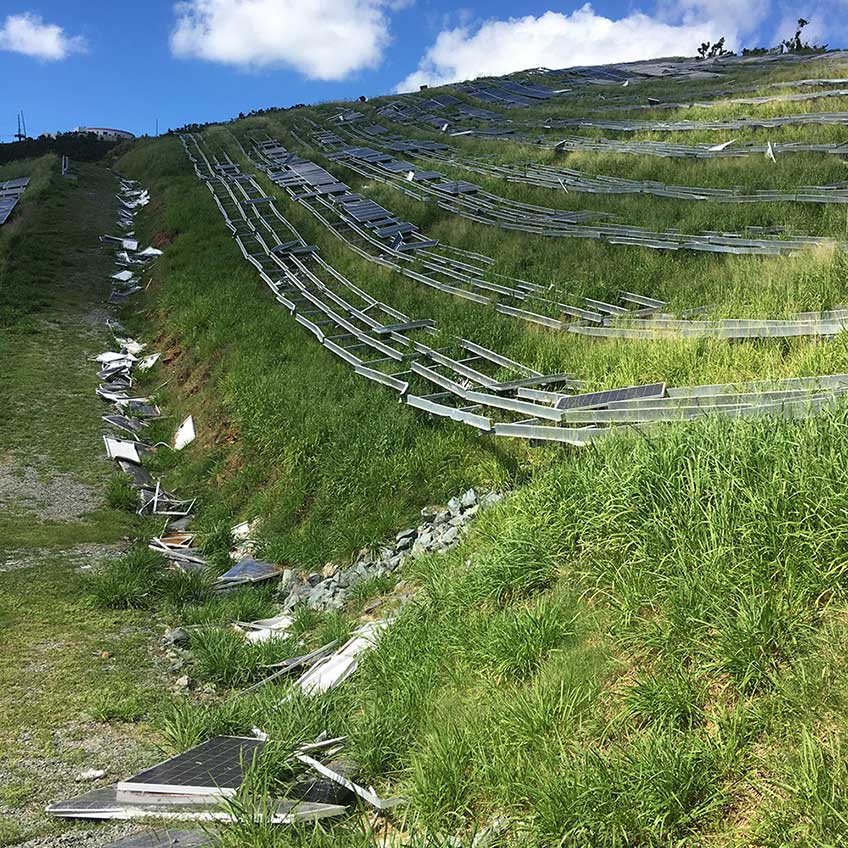PV Survivability from Hurricanes: Lessons Learned
Sept. 6, 2018 by Eliza Hotchkiss
Last year, two Category 5 storms, Hurricanes Irma and Maria, ripped through the Caribbean within a two-week period, devastating island communities. Hurricane Irma hit the U.S. territory of the U.S. Virgin Islands (USVI) on September 6th, 2017, with the eye passing over St. Thomas and St. John. On September 20th, the eye of Hurricane Maria swept near St. Croix with maximum winds of 175 mph. The USVI estimate uninsured losses at close to $7.5 billion, including damages to roughly 80-90% of the power transmission and distribution systems and a number of solar photovoltaic (PV) generation systems.
The National Renewable Energy Laboratory (NREL) has been engaged in series of disaster recovery and energy resilience efforts in the region. NREL’s Solar Technical Assistance Team (STAT), for example, recently conducted a high-level rooftop PV technical potential assessment of St. John Island for the USVI Water and Power Authority (VIWAPA). STAT also provided summary information and considerations related to utility-owned rooftop solar programs to inform VIWAPA’s rooftop PV program design.
In addition to providing data and analytical support, NREL has been active in assessing on-the-ground impacts of the 2017 hurricanes on existing PV infrastructure in the USVI. In recent years, the USVI has installed PV arrays and other renewables to reduce reliance on costly and logistically challenging fossil fuel-based electricity. The USVI set a goal in their Energy Roadmap to reduce reliance on fossil fuels by 60% by 2025. Programs to upgrade energy generation equipment, implement energy conservation measures, and integrate renewable energy generation have been progressing the islands towards that goal. But the 2017 hurricane season was a huge setback in those efforts. To put the USVI and other Caribbean island communities back on track, and to limit impacts from future hurricane events, it is important to understand points of failure and why some PV systems did not survive the hurricanes, while others did. Lessons learned in disaster recovery locations can serve as best practices for future-proofing renewable energy systems so that they can continue to provide power when the next hurricane strikes.
The destruction of a 4.2 megawatt (MW) PV system on St. Thomas (see Figures 1 and 2) was devastating, but it presents an opportunity to assess what went wrong and what improvements can be made to avoid similar outcomes in the future. The images below show the PV system before and after the hurricanes.
Figure 1. A 4.2MW PV array on St. Thomas pre-September 2017

Figure 2. The Same 4.2MW PV array on St. Thomas in December 2017

Although deeper assessments of systems such as this one are ongoing, initial observations
are beginning to highlight issues and potential solutions. Researchers from the National
Renewable Energy Laboratory (NREL) conducted site visits to Puerto Rico and the USVI
and determined that performance of PV systems, both ground- and roof-mounted, varied
greatly. Not all PV systems were destroyed—some only had a few impact marks from flying
debris and others remained unscathed. In other cases, panels were damaged by flying
objects: panels became detached, at which point they were destroyed on impact, or
themselves became windborne debris that damaged other panels. In other instances,
system components were dislodged or destroyed by debris and water intrusion.
Based on initial observations, a few recommendations for installations and maintenance of PV systems in high wind or hurricane prone areas come to the forefront:
- Use stainless steel cabinets with multiple door attachments rather than single rod closures to prevent water intrusion;
- Establish standards and design specifications such as those for materials used in PV modules and racking systems (qualification testing, UL1703 IEC61215, NEC code, IBC 1507.17.3 where applicable, etc.);
- Verify installation (e.g., check connections with a torque wrench; review and verify proper assembly and connections; perform acceptance tests, such as static and dynamic load tests);
- Perform regular maintenance of components (e.g., torqueing pre-hurricane season, conducting electrical testing, etc.);
- Consider site-specific conditions for siting and design: differences in topography to avoid sail or chimney/stack effect, racking installation (e.g., piers), soil conditions, and overhang location;
- Modify operational procedures, such as adjusting tilt of arrays pre-storm or cover with protective materials;
- Consider through-bolting rather than clamping module frames; or a combination of clamps and through-bolts;
- Investigate panel design modifications that would accommodate more secure attachments, such as through-bolting;
- Utilize microinverters to support partial operations with partial system destruction.
The 2017 hurricane season reinforced the notion that PV systems cannot be expected to be 100% resilient 100% of the time. The resulting damage to PV systems during hurricanes have offered some opportunities to assess the impacts and begin to identify some low-cost best practices to improve resilience of PV systems. In the coming months and years, further assessments and systematic approaches can identify additional PV system design approaches that can minimize or prevent PV system failures during hurricanes to help improve full or partial PV system resilience.
Share

